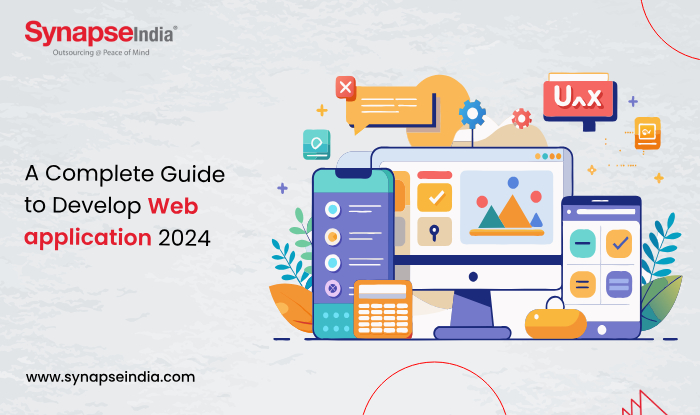 19 Sep 2024
19 Sep 2024“Web application development is the easy path to get a business application that can offer dynamic user experience, broad accessibility and enhance user engagement through interactive and personalized experiences.”

Web applications have become a new trend for businesses that want dynamic applications but do not want to go for native app development. Web applications offer numerous perks like easy accessibility, low development and maintenance costs, better security features, and much more. Moreover, they also deliver flexibility, efficiency, and enhanced user engagement.
For organizations looking forward to enjoying the benefits of web apps, they can refer to this comprehensive guide on web application development . Alternatively, they can hire a professional website development company to help them out with custom web application development for their business.
A web application is a software application program that runs on a remote web server. Users can interact with web applications through a web browser over an internet or intranet network. Since web applications can be accessed via a remote server, it eliminates the need for installing the application locally on a device.
Web applications require a web server, an application server and a database to function. The web server receives the request from the client side and transfers it over to the application server. The application server retrieves necessary information stored in the database and returns it over to the web server.
Here’s a step-by-step explanation of how a web application works:
There are different types of web applications, each of which is designed to meet specific user needs and operational requirements. The most common types of web applications include:
Static web applications are the simplest kind of web apps that serve fixed content to users. The content of static apps remains the same for every visitor and does not change dynamically. Such web apps are very easy to design and develop.
Dynamic web applications generate dynamic content in real time based on user interaction. These applications are designed to provide personalized experiences to the users.
Single-page applications load a single HTML page and dynamically update content based on user interaction. It does not require any browser reloads and therefore offers fast and agile performance. They also have a simple development process and rapid deployment.
Multi-Page Applications have multiple pages and whenever a user interacts with such applications, a new page is loaded from the server and displayed. Their development process is a little bit complex, but they are good from the SEO point of view.
Progressive web applications are designed to offer performance and experience like native apps. These applications are installed on the user’s device and can work efficiently in poor connectivity or offline depending on its design.
E-Commerce web applications E-Commerce web applications are designed to facilitate online buying and selling of products or services. These applications are designed with features for scalability, analytics and integration capabilities.
Web applications offer benefits to both businesses and users and offer an efficient way to deliver software solutions. Some of the benefits of web apps include support scalability, accessibility, and ease of maintenance.
Users can easily access web applications from any device using any web browser and from anywhere with an internet connection. There is no need to install the application on the user’s device as access is provided via a remote web server. This also eliminates the need to manually update the application for new features and improvements.
Web applications can be designed to be responsive, ensuring a consistent user experience across different devices and operating systems. This is important to provide a consistent user experience which in turn can enhance user satisfaction.
Web applications offer effortless scaling by upgrading server infrastructure or using cloud services to handle increased traffic and data load. As most web application data is stored in the cloud, there is no need to invest in infrastructure, costly hardware, or additional storage capacity to run web apps.
Updates and bug fixes in web applications can be applied centrally, i.e., on the server side which is reflected automatically for all users’ interactions. Thus, the users will always have the access to the latest version of the web app without installing the updates individually
Web applications offer cost-effectiveness in development, distribution, and maintenance. Fewer resources are required to develop a web application as compared to native applications that are developed for different operating systems. Moreover, they also offer cost savings by eliminating the need for app store distribution since these apps are accessible through web browsers.
By allowing changes to be made to a single codebase, web applications also reduce the costs involved with maintenance and updates.
Web applications offer easy integration with other web-based services, APIs, and systems. This allows for streamlined workflows and enhanced functionality and data sharing. Additionally, web apps can also be customized easily to meet the specific needs of businesses.
Web applications offer enhanced security by receiving software and security updates automatically and centrally. This means that they are always up to date and less at risk of security breaches. Web apps also include data backup and recovery processes to protect against data loss.
Web applications, websites & mobile applications differ from each other in terms of development, installation, user interaction, accessibility and offline capabilities.
Web Applications are developed using general programming languages and do not require any installation. Websites are more or less similar to web applications in terms of development and installation. Mobile applications are developed using platform-specific languages or cross-platform tools and need to be installed through app stores.
Web applications offer high interactivity and are developed to perform specific tasks. Websites primarily provide static content and therefore have limited interactivity. Mobile applications are also highly interactive but are optimized specifically for mobile experience.
Both web applications and websites can be accessed via web browsers but to access mobile applications users need to install them from app stores.
Web applications mostly require an internet connection but can include some offline features. Websites generally require an internet connection whereas mobile applications can offer full functionality offline depending on the design.
Now that you know all about web applications, it’s time to learn about their development process. Here is a complete guide to developing an interactive web application from scratch.
A great app develops from a great idea. The first stage of web application development is ideation which is an important stage as it sets the foundation of the development process. You can gather ideas from market research to understand the target audience, find out their problems and decide on an application that would help solve their problems. Determine the objective of your application and create a plan on how it will differ from what the competitors are offering.
Planning also involves defining the core functionality of the web application. Key features for the application must be decided in advance to ensure its timely and successful delivery while the other non-essential features can be put aside for future updates. Also, don’t forget to plan your budget and timeline.
An initial application design is important to ensure that you create an app that is not only aesthetically appealing but also has a functional interface. App designing involves developing wireframes and prototypes and creating user interface and user experience.
Wireframes are like the basic layout of your application that allows you to visualize the user interface and plan the navigation. Prototypes, on the other hand, offer clear guidelines for the app’s framework and provide an understanding of the functionality and behavior of the app.
An intuitive UI/UX design is the basis of a successful application as it can determine the ease with which users will interact with your web app. Moreover, the interface should be designed to be responsive so that the users get an enhanced experience while browsing your application on different devices.
The front end of a web application is the face of the app that the users will interact with. Frontend development involves creating a dynamic and visually appealing web app using HTML, CSS, and JavaScript languages alongside proper frameworks.
HTML is used to build the structure of your web application with elements like headings, paragraphs, and links. CSS mainly controls the appearance of your application by designing layout, colors, fonts, and responsiveness. Using JavaScript, you can add interactivity to your application via form validation, dynamic content updates, and client-side logic.
Backend development includes creating the server-side software that powers the web application. During backend development, developers write code using programming languages like Python, PHP, Java, etc. alongside popular frameworks to create important components.
A database is created to store and retrieve data and Application Programming Interfaces are created to allow the frontend to communicate with the backend. The backend development process also includes implementation of security measures to protect user data and ensure proper access control.
After the application development comes testing, which is a crucial stage as it determines the functionality of your app. Testing is important to ensure that the application functions as envisioned without presenting any bugs or issues. During testing, you must test individual components of the applications and also test their functioning when working as a whole system. Essential software testing parameters include functionality, performance, usability, security, and compatibility testing.
Deployment refers to the transfer of the application to the production environment where it becomes accessible to users. Now for your web app deployment, you need to select a hosting service and register a domain name that represents your web application. Using appropriate deployment tools and services you can now upload your application to the server.
Once the app is live and running, it is now time to monitor its performance to make sure that all the functions of the application work smoothly. The app also needs to be monitored for security issues and any defect or vulnerability found must be fixed promptly.
Web app development involves several stages from planning to successful implementation. The process can be a little daunting for someone with low experience in web development. Getting help from an expert in the field is the most efficient way to get a high-quality web application developed for your business.
Expert web app developers can provide a custom-designed application, tailored to meet the specific demands and challenges of your business. They bring years of experience and in-depth knowledge in custom web app development, both of which are crucial for developing an app that exceeds expectations.
A custom web app can bring several advantages to your business and is important to drive success in this digital landscape. If you are also looking for a web app for your business but the process of web app development feels overwhelming, you can find yourself a development partner. Selecting the right development partner can help turn your vision into a successful web application. Hiring a custom web development company can take care of the complete development process from initial consultation to the final product delivery.


 01 Jun 2024
01 Jun 2024
